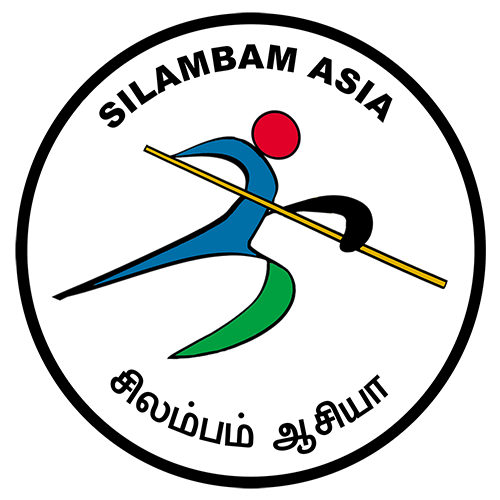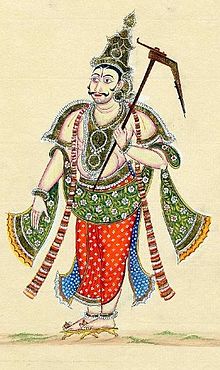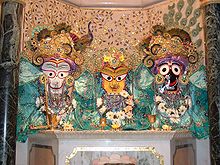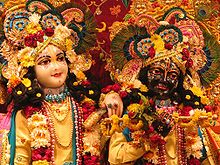Balarama
|
Balarama (बलराम, Balarama), also known as Baladeva, Balabhadra and Halayudha, is the elder brother of Krishna (an avatar of the god Vishnu) and is regarded generally as an avatar of Shesha. He is also sometimes considered as the Sankarshana form of Vishnu and the eighth avatar of Vishnu. He may have originated in Vedic times as a deity of agriculture and fertility. In scripture, Vishnu impregnated the belly of the goddess Devaki with two strands of hair, one black, one white. To ensure their safety, they were transferred before birth to Rohini. Krishna was born with darker complexion, while Balarama was fair. In Jainism he is known as Baladeva. He is often depicted with a drinking cup, pitcher, shield and sword. Early lifeBirth and originBalarama was a son of Yadava king Nanda. The evil king Kamsa, the brother of Devaki, was intent upon killing the children of his sister because of a prediction that he would die at the hands of her eighth son. Vishnu then impregnated the belly of the goddess Devaki with two strands of hair, one black, one white. To ensure their safety, their essence was transferred before birth to Rohini, who also desired a child. At birth, Krishna had a darker complexion, while Balarama was born fair. The other name of Balarama is also Sankarshana, meaning a spirit transferred between two wombs. He was named Rama, but because of his great strength he was called Balarama, Baladeva or Balabhadra, meaning "Strong Rama". He was born under Shravana nakshatra on Shraavana Purnima, or Raksha Bandhan. He is often depicted with a drinking cup, pitcher, axe, shield and sword. Balarama may have originated in Vedic times as a deity of agriculture and fertility. In Jainism he is known as Baladeva. Childhood and marriageOne day, Nanda Maharaja requested the presence of Gargamuni, his priest, to name the newborn Krishna and Balarama. When the Gargamuni arrived, Nanda Maharaja, received him well and requested the naming ceremony. Gargamuni then reminded Nanda Maharaja that Kaṁsa was looking for the son of Devaki, and if he performed the ceremony in opulence, it would come to his attention. Nanda Maharaja therefore asked Gargamuni to perform the ceremony in secret, and Gargamuni did so:
Balarama spent his childhood as a cow herder with his brother Krishna. He killed Dhenukasura, an asura sent by Kansa, as well as Pralambasura and Mushtika wrestlers sent by the king. After the evil king died, Balarama and Krishna went to the ashrama of sage Sandipani's at Ujjayini for study. He later married Revati, the daughter of King Kakudmi, ruler of Kushasthali or Anarta Kurukshetra war of the MahabharataBalarama taught both Duryodhana of the Kauravas and Bhima of the Pandavas the art of fighting with a mace. When war broke between the Kauravas and the Pandavas, Balarama cared for both sides, and so remained neutral. When the mighty Bhima defeated the more skilled Duryodhana by striking him in the groin with his mace, Balarama threatened to kill Bhima. This was prevented when Krishna reminded Balarama of the vow of Bhima—to kill Duryodhana by crushing the thigh he had exposed to Bhima's wife Draupadi. DisappearanceIn the Bhagavata Purana, it is described that after Balarama took part in the battle causing the destruction of the remainder of the Yadu dynasty, and witnessing the disappearance of Krishna, he sat down in a meditative state and departed from this world. Some scriptures describe a great white snake that left the mouth of Balarama, in reference to his identity as Ananta-Sesha. The place where he departed is situated near Somnath Temple in Gujarat. The local people of Veraval believe that the in cave near the temple place, the white snake who came out of Balarama's mouth got into that cave and went back to Paatal Lok. Status as avatarMain article: Dashavathara
Narratives of Balarama are found in the Mahabharata, Harivamsha, Bhagavata Purana and other Puranas. The Bhagavata Purana suggests Balarama as incarnation of Vishnu. He is classified in the vyuha avathar Sankarshana, of Vishnu where in Adishesha and Lakshmana is part of. WorshipAn earlier reference to Balarama is in Kautilya's Arthashastra (13.3) Early individual Balarama worship was followed by obeisance to Balarama alongside Krishna in various Vaishnava sects. The most revered temple of Balarama is in Kendrapada and in Puri in Odisha. 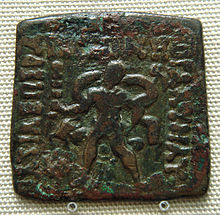
Maues coin depicting Balarama, 1st century B.C.E. Sage Atri's Samurtachanadhikara of Vaikhanasas, the most ancient school of Vaishnava theology, has described protocols for building temples and idols for Balarama and his consort. The Pancharatras, one of the earliest Vaishnava sects, worshiped Samkarshana as the second vyuha of Godhead. Krishna is usually depicted darker than Balarama. In Rama-lila, Balarama serves Ramachandra as his younger Brother, Lakshmana and in the current age (Kali yuga), Balarama spreads the 'Sankirtan movement' of Chaitanya Mahaprabhu as his close friend Nityananda. 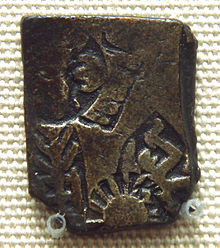
Balarama at the lower right of a Maurya coin, holding a mace and conch; 3rd-2nd century B.C.E., from the British Museum Gaudiya Vaishnavas believe Balarama to be the supreme divinity, and worship him in the same level of Krishna as Balaram is considered to be the source of all Vishnu forms.In their belief system, when Krishna is depicted, Baladeva is also always shown as his brother—sometimes elder, sometimes younger. They depict Balarama serving Krishna in all of his incarnations. Krishna has been described as creator, and Balarama his creative potency, with them being worshiped together as embodiment of Godhead.
17th century mural of Balarama in a south Indian temple Appearance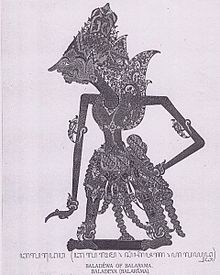
Balarama in Javanese Wayang Balarama is depicted as fair skinned, in contrast to his brother, Krishna, who is dark skinned, Krishna in Sanskrit means dark. His ayudhas, or weapons, are the plough hala and the gada. He often wears blue garments and a garland of forest flowers. His hair is tied in a topknot, and he has earrings, bracelets and armlets, and he is known for his strength. JainismThe Jain Puranas, notably, the TrishashtiSalakapurushacarita of Acharya Hemachandra, narrate hagiographical accounts of nine Baladevas or Balabhadras, who are believed to be the Salakapurusa's (literally "torch-bearers, great personalities"). These nine Baladevas are: Achala, Vijaya, Bhadra, Suprabha, SuDarSana, ananda, Nandana, Padma (Rama in Hinduism) and Rama (Balarama in Hinduism). TemplesBaliyana Mandir, Bainsa (dist Nawanshahr) Punjab
Quotations
References
|
|||||||||||||||||||||||||||||||||||||||||
